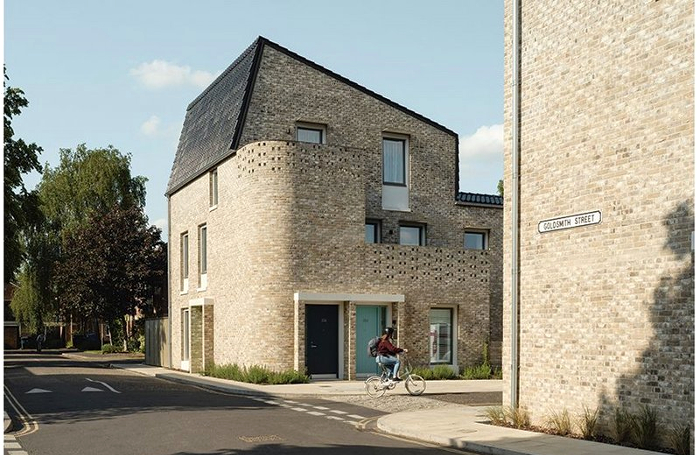Created by Mikhail Riches with Cathy Hawley, the 2019 Stirling Prize winning design, 'Goldsmith Street', has received a lot of attention.
Hailed for its clever placemaking, impeccable detailing, green credentials, and generous family-friendly public spaces, this council development has been deservedly held up as an exemplary model for the UK’s public housing sector.
What is lesser known is that the project was initially sparked by a RIBA competition. This makes it the second to have won the annual Stirling Prize – the first being Hastings Pier, designed by dRMM, which won in 2017.
The story of Goldsmith Street goes all the way back to 2008. Having identified a prominent site in central Norwich, the local authority, Norwich City Council, wanted to set a high quality benchmark for their affordable housing development plans.
After considering the options, their Delivering Affordable Housing Partnership (DAHP), a consortium comprising several housing associations as well as Norwich City Council, decided that a design competition was the best way to identify an architect capable of fulfilling their vision.
To be sure to attract the best talent, DAHP wanted to use an independent, reputable competitions agency to oversee the process. They appointed RIBA Competitions, based on recommendations from other councils and developers.
There are several ways to secure designers under EU public procurement rules. After taking advice from RIBA Competitions, DAHP opted for an ‘invited design competition’, a decision that paid off.
The two-stage format attracted over 100 expressions of interest from the UK, Ireland, the Netherlands and Japan. Riches Hawley Mikhail (as they were known then) were shortlisted and eventually won in 2009, beating off competition from Letts Wheeler Architects, Maccreanor Lavington, Make, and ShedKM.
David Mikhail, Mikhail Riches’ founding partner, describes RIBA’s process as ‘exemplary’. Entering competitions is an important work-winning strategy for them, and they know what they do and do not like to find in the process. While he concedes that other competition formats have their place, the Goldsmith Street one stood out because it properly acknowledged the architects’ investment of time and skill.
For example, the two-stage process limited the amount of at-risk upfront work. The major workload only kicked in after the initial expression of interest, sweetened by a £5,000 honorarium which Mikhail viewed as a welcome "mark of respect".

The outcomes-based brief; involvement of an architect assessor on the jury, and reassurance that the design approach counted for more than the fee quotation all confirmed that the client understood the value of good design.
Best of all was the chance to meet and present their work to the client. “Our base criterion is to be able to engage with the client before we spend hours, weeks or even months designing,” explains David Mikhail.
“The architect’s job is partly about serving the community, partly about your own interests, but it is also about distilling and giving shape to client’s values and aspirations. You cannot do that from a page of A4. You have to meet them.”
The timing of the competition was unfortunate. The global financial crisis had already begun to bite, affecting the ways registered providers could approach the project. Norwich City Council decided to move away from working with them, which of course curtailed their funding options, and so the project was put on hold.
This had a dramatic effect on Hawley Riches Mikhail, contributing to a difficult period that saw them restructure as Mikhail Riches - but it worked out in the end. A refinancing of the Housing Revenue Account meant that Norwich City Council could engage directly with the architects, and the project was resurrected in 2014. This time it came with a subtly different set of ambitions. For example, Mikhail Riches were able to apply 'Passivhaus' standards to the scheme; a factor that no doubt helped it to win the Stirling Prize.
David Mikhail is positive about the RIBA Competitions service and their procedural governance. “They reassured us that it was a worthwhile scheme, which encouraged us to work incredibly hard to win it,” he states. “I think that comes across in our eventual design.”
Planning was eventually secured in February 2016. After a further six months of value engineering, the project finally started on site in January 2017. Upon completion in the summer of 2018, the delighted client described it as ‘fantastic’, and the scheme’s Stirling triumph came a year later.
“It proves that it is possible to hire practices that don’t have a track record,” Mikhail enthuses. “All it takes is a client with the right mindset.”
Thanks to David Mikhail, Founding Partner at Mikhail Riches.
Text by Matthew Thompson. This is a Professional Feature edited by the RIBA Practice team. Send us your feedback and ideas.
RIBA Core Curriculum Topic: Business, clients and services.
As part of the flexible RIBA CPD programme, Professional Features count as microlearning. See further information on the updated RIBA CPD Core Curriculum and on fulfilling your CPD requirements as an RIBA Chartered Member.









